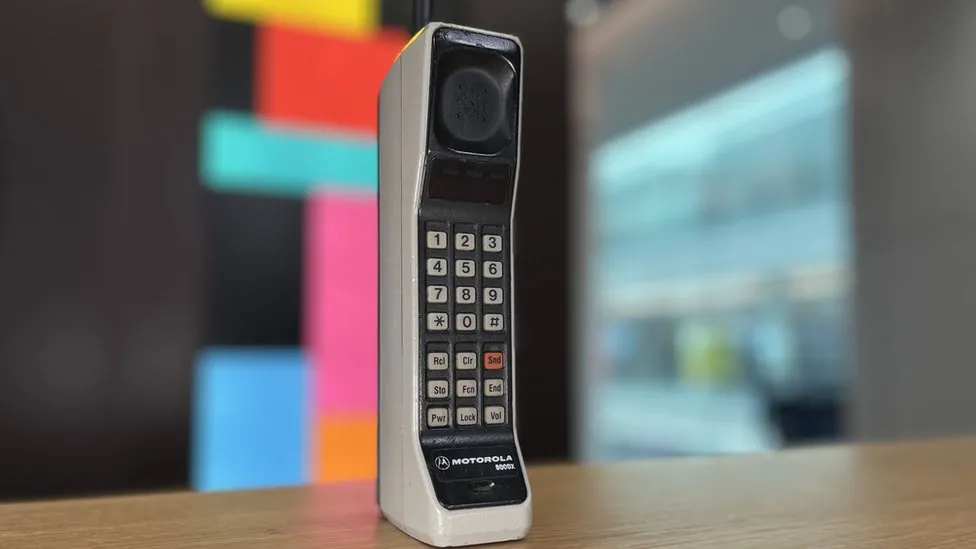You share your carefully created photo online and it suddenly appears as a poor imitation of what you’re seeing on your camera phone – fuzzy edges and block skies. It might not matter for throw away images but it does for more important ones. For example, say you want to share a photo of your creative work for showing and selling. Or, a special photo of a favourite place. Read on to understand why photos sometimes fall apart when uploaded and what you can do about it.
The ubiquitous and fabulous JPEG format
Until 1986 there was no way of displaying a photographic image on a computer screen (and camera phones weren’t around until 1999). A group of scientists got together to find a way – they were called the Joint Photographic Expert Group (or JPEG!). Search online if you’ve geeky inclinations and want to know the complex maths behind how JPEGS are created – we’re just staying outside of the blackbox here!

The Motorola Dynatac 8000X, was released 11 years after the first mobile call, in 1984. It would cost the equivalent of £9,500 ($11,700) if bought today (bbc.co.uk)
A JPEG uses some clever mathematics to convert a complex RGB (red green blue) photo into something simpler. Something that a computer/phone can display on its screen and also take up less storage space. Importantly, JPEGs are small enough to share through the internet’s narrow data highways.
Why do JPEGS lose quality
By their nature, JPEGS are lossy – they remove information from an RGB image to make it smaller (lost information, hence lossy). A couple of things happen: JPEGs process information in 8×8 blocks of pixels – whereas larger RAW files use individual pixels. RAW files are the unprocessed raw ingredients from a camera sensor. JPEGs aggregate the information from 64 (8×8) individual pixels, removing some details from the raw data. Cleverly, the JPEG retains more detail about brightness (Luma) than colour (Chroma) as the human eye is more sensitive to differences in brightness than colour. Therefore, we don’t generally notice what is missing.
Now, because JPEGs are working with blocks of pixels, the more we mess with them, the less well they fit together. A bit like those frustrating children’s block puzzles. Messing can be through destructive editing of images (see article on non-destructive editing). This includes extreme adjustments that stretch pixel information (colour or brightness). Or, in the case of online sharing, social media platforms remove further information from JPEGs so they fit their image size requirements. This causes further degradation. Social media compression algorithms quickly process large volumes of images, and image quality isn’t the only consideration.
Degradation is often most noticeable in expanses of colour with subtle tonal and colour variations (sky for example). The JPEG removes information from these areas, treating them as so similar they are rendered the same. Things can turn ugly in extreme cases. You might notice fringing around the edges of subjects and skies that look blocky and pixellated.

Example kindly provided by member of our camera phone Facebook community. The photo looks perfect on the phone, but look closely at this copy downloaded from Facebook. Notice the halos around the balloons and how the sky is beginning to appear blocky.
How to minimise degradation.
You can minimise fuzzy edges and blocky skies in your photos. Take care of your JPEG files before you release them into the world. Ensure your phone is set to capture images using the highest quality JPEGs – beware of space-saving options. Use non-destructive editing techniques. Or, if you don’t have the tools for that, edit in one session and leave alone.
Modern camera phone images are large files, generally of 12MP (mega pixels) – enough to make a 12inch photo print and more than enough to fill an HD television screen. They are way too big for social media sites that like images to be between 1 and 4MP (this changes over time). The only way to stop the rough algorithms from mincing your large files is to resize them on your phone, using its own computing power. Or, use a computer. You’ll possibly need a phone app to do this (eg the free version of Photoshop Express).
All this involves extra time and effort, so for images that are not so important, it’s more convenient to let the algorithms do their worst – on some images you might not even notice.
Some newer camera phones have the option of shooting photographs in an uncompressed raw format. Think carefully about whether you need this for you images before taking the plunge – they are much larger files, so will quickly fill your phone and cloud storage. An article will follow on using the raw format on camera phones.